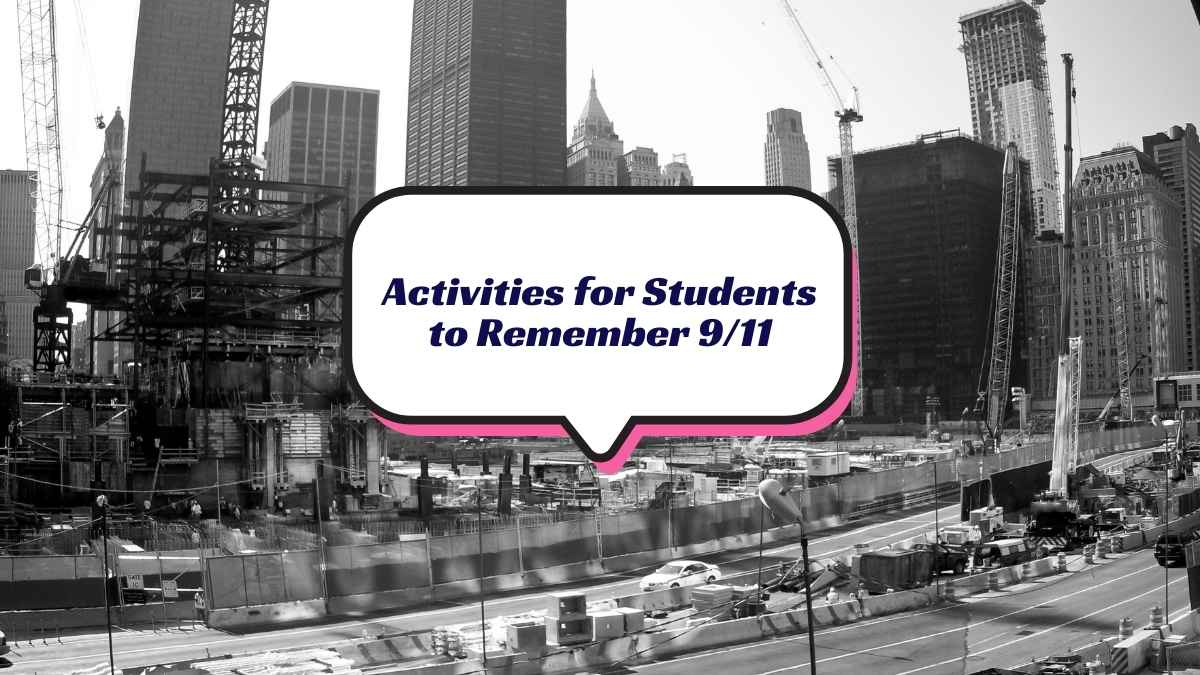9 Engaging Activities for Students to Remember 9/11.
September 11th, 2001 is a day that will forever be remembered in the history of America. It was a day that changed the lives of many Americans, and left a lasting impact on the nation.
On this day, terrorists attacked the United States, targeting the World Trade Center in New York City and the Pentagon in Washington D.C. This tragic event has left many people with questions about what happened and why.
Table of Contents
Honoring the Memory of 9/11 through Education
Teaching students about 9/11 is an important part of helping them understand the events of that day, and the impact it had on the nation. This article provides an overview of 9/11, and outlines activities for teaching about the event in elementary, middle, and high school classrooms.
The events of September 11th, 2001 are a day that will never be forgotten. On this day, the United States was attacked by terrorists who hijacked four planes and flew them into two iconic buildings in New York City – the World Trade Center towers – as well as one plane into the Pentagon in Washington D.C., and another which crashed near Shanks Ville, Pennsylvania. This tragic event changed America forever and it is important to remember those who lost their lives on that fateful day.
Discussing 9/11 with Students: Tips and Strategies
Teaching students about 9/11 can help ensure they understand its significance while also honoring those affected by it. In this blog post we will discuss what happened on 9/11, how to talk about it with age-appropriate language for different grade levels, activities for teaching about 9/11 in elementary school classrooms through high school classrooms and resources available to teachers when discussing 9/11 with students.
9/11 is the day that will forever be remembered as one of the most tragic events in American history. On September 11th, 2001, terrorists hijacked four planes and flew them into two iconic buildings in New York City – the World Trade Center towers – as well as one plane into the Pentagon in Washington D.C., and another which crashed near Shanksville, Pennsylvania.
Attacks resulted in nearly 3,000 deaths
The attack resulted in nearly 3,000 deaths with thousands more injured or left without homes due to destruction caused by these acts of terrorism. 9/11 was a defining moment for America; it changed our nation’s security protocols while also leaving an indelible mark on those who experienced its aftermath firsthand or through media coverage around the world.
The events of September 11th, 2001 began with the hijacking of four commercial airplanes by terrorists. Two planes were flown into the World Trade Center towers in New York City, one plane was crashed into the Pentagon in Washington D.C., and a fourth plane crashed near Shanksville, Pennsylvania after passengers attempted to retake control of it from their captors.
In response to this tragedy, many memorials have been erected around the world as a tribute to those who lost their lives on that day – including two reflecting pools at Ground Zero where each tower once stood surrounded by trees planted for remembrance; an annual national observance held every year since 2002; and multiple museums dedicated solely to preserving artifacts related 9/11 such as photographs and personal items found among debris from both sites.
These efforts serve not only as reminders but also help ensure future generations will never forget what happened on that fateful day nor its impact on our nation’s history forever changed America’s security protocols while leaving an indelible mark on those affected directly or indirectly
The impact of the 9/11 attacks on America and Americans was devastating. Not only did it result in thousands of lives lost, but it also had a profound effect on our nation’s security protocols and left an indelible mark on those affected directly or indirectly. The attack resulted in sweeping changes to airport security measures, increased surveillance efforts by government agencies, and heightened public awareness about potential terrorist threats both at home and abroad.
It also led to a greater sense of patriotism among citizens who felt compelled to stand united against terrorism as well as a renewed appreciation for the freedoms we often take for granted here in America. Finally, many people experienced personal grief due to loss of loved ones or friends during this tragedy which has been difficult for individuals across the country even two decades later.
Use Age Appropriate Language
When discussing 9/11 with students, it is important to remember that the language used should be age-appropriate. For younger children, focus on explaining what happened in simple terms and emphasizing how we can honor those who lost their lives by being kind to others and standing up for justice. It may also be helpful to provide resources such as books or videos about 9/11 which are specifically designed for young learners.
Older students will likely have a better understanding of the events so more detailed conversations can take place focusing on topics such as terrorism, security measures implemented since then and even personal stories from individuals affected by the attacks directly or indirectly. Regardless of grade level though, teachers should strive to create an open dialogue where questions are encouraged while ensuring all discussions remain respectful towards those impacted by this tragedy.
Activities for Teaching About 9/11 in Middle Students
When discussing 9/11 with middle school students, it is important to use age-appropriate language and activities that help them understand the significance of this event while also honoring those affected by it. There are a variety of ways teachers can approach teaching about 9/11 in their classrooms including:
- Have students watch documentaries or read books related to the attacks and discuss how they felt after viewing these materials;
- Create an art project where each student designs a memorial for victims of the attack;
- Ask students to research different organizations that support families who lost loved ones on 9/11 such as Tuesday’s Children or MyGoodDeed;
- Invite guest speakers from first responder groups like firefighters, police officers, EMTs etc., who were present at Ground Zero during rescue efforts following the attacks; • Host debates between classes on topics related to terrorism and national security policies enacted since 2001.
These activities will help engage middle schoolers in meaningful conversations about what happened on September 11th while also providing opportunities for reflection and discussion around its lasting impact both domestically and abroad.
Teaching About 9/11 in high school classrooms
When teaching about 9/11 in high school classrooms, activities should be designed to help students understand the significance of this event while also honoring those affected by it. Teachers can have their classes engage in meaningful conversations around topics such as terrorism, security measures implemented since then and personal stories from individuals impacted directly or indirectly.
Additionally, having students research different organizations that support families who lost loved ones on 9/11 is a great way for them to gain an understanding of how these events continue to affect our nation even two decades later. Finally, teachers can assign projects where each student designs a memorial for victims of the attack or create debates between classes on topics related to national security policies enacted since 2001 which will encourage critical thinking skills while helping foster appreciation for our freedoms here in America.
You need to follow resources
When discussing 9/11 with students, teachers and parents have access to a variety of resources available to help them facilitate meaningful conversations. The National September 11 Memorial & Museum offers educational materials such as lesson plans, videos, activities and more which can be used in the classroom or at home when talking about this tragedy. Additionally, there are several books specifically designed for young learners that explain what happened on 9/11 in an age-appropriate way including “September 12th: We Knew Everything Would Be All Right” by Masterson Elementary School Students (ages 6-12) and “Where Were You On September 11?” by Faith McNulty (ages 8-14). Finally, organizations like Tuesday’s Children offer support groups for families affected directly or indirectly by the attacks while MyGoodDeed provides volunteer opportunities related to honoring those lost during this tragedy.
Conclusion – Activities for Students to Remember 9/11
In conclusion, the events of September 11th, 2001 are a day that will never be forgotten. Teaching students about 9/11 is an important way to ensure they understand its significance while also honoring those affected by it.
There are many activities and resources available for teachers and parents when discussing this tragedy with their students ranging from elementary school through high school classrooms. These conversations can help foster understanding and appreciation for our nation’s freedoms which were threatened on September 11th as well as provide opportunities for reflection around topics such as terrorism, security measures implemented since then and personal stories from individuals impacted directly or indirectly by these attacks.

